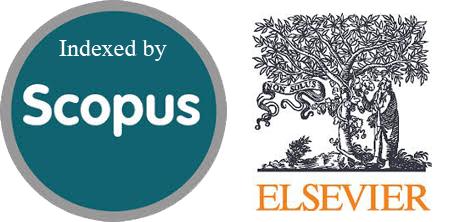Investigating the Role of Interleukin 8, Toll-Like Receptor 3, and Liver Enzymes in Iraqi Patients with Hepatitis C Virus
DOI:
https://doi.org/10.54133/ajms.v8i2(Special).1358الكلمات المفتاحية:
HCV، IL-8، Liver enzyme، TLR-3، Viral loadالملخص
Background: Hepatitis C virus (HCV) is the most common chronic blood-borne infection. Individual variations in immune responses may help define successful resistance to infection with HCV. Objective: This study was planned to estimate the levels of IL-8, TLR3, and liver enzymes in HCV patients. Methods: Three hundred blood samples were collected from HCV patients and 50 samples from healthy controls from December 2022 to May 2023. All samples underwent HCV Ab and viral load measurements for HCV (Ab+). Ninety samples were taken at the age (20-60) years and then divided into three groups. The first group consisted of thirty HCV-infected patients with detectable viral loads, while the second group consisted of 30 HCV-infected patients with undetectable viral loads. The last group consisted of 30 healthy individuals for comparison purposes. Results: This study showed there were non-statistical differences between the studied group in age and sex and a high statistical difference in ALT, AST, and ALP, while there were non-statistical differences with ALB, BILD, and TSB. The mean value of IL-8 and TLR-3 was higher in infection with undetectable viral load patients than in the other group. Conclusions: This study concluded that IL-8 and TLR-3 had higher levels in HCV undetectable viral load patients than in the other group.
التنزيلات
المراجع
Karimkhanilouyi S, Ghorbian S. Nucleic acid vaccines for hepatitis B and C virus. infection. Genet Evolut. 2019;75:103968. doi: 10.1016/j.meegid.2019.103968. DOI: https://doi.org/10.1016/j.meegid.2019.103968
Rasheed NFA, Jassim HS, Hassan AS. Assessment of some heavy metals and trace elements in a sample of patients with viral hepatitis in Baghdad. J Techniques. 2022;4(3):8-13. doi: 10.51173/jt.v4i3.507. DOI: https://doi.org/10.51173/jt.v4i3.507
Wei Y, Li J, Qing J, Huang M, Wu M, Gao F, et al. Discovery of novel hepatitis C virus NS5B polymerase inhibitors by combining random forest, multiple e-pharmacophore modeling and docking. PloS One. 2016;11(2):e0148181. doi: 10.1371/journal.pone.0148181. DOI: https://doi.org/10.1371/journal.pone.0148181
Kundal V, Qureshi S, Mahajan S. Chronic liver disease: Etiological spectrum in adults. JK Sci. 2017;19(3):145-149.
Al-Azzawi KGR, Al-Naqeeb AAAG, Zeidan MAK. Impact of chronic liver diseases on specific health-related quality of life among a sample in Babylon governorate. J Techniques. 2022;4(Special Issue):86-90. doi: 10.51173/jt.v4i33.648. DOI: https://doi.org/10.51173/jt.v4i33.648
Marcellin P, Kutala BK. Liver diseases: A major, neglected global public health problem requiring urgent actions and large‐scale screening. Liver Int. 2018;38:2-6. doi: 10.1111/liv.13682. DOI: https://doi.org/10.1111/liv.13682
Page K, Morris MD, Hahn JA, Maher L, Prins M. Injection drug use and hepatitis C virus infection in young adult injectors: using evidence to inform comprehensive prevention. Clin Infect Dis. 2013;57(suppl_2):S32-S38. doi: 10.1093/cid/cit300. DOI: https://doi.org/10.1093/cid/cit300
Al-Mola G, Tarish H, Abdulsada K, Lateef R. Investigation of the major HCV genotype in asymptomatic patients in Iraq by the use of reverse-transcription PCR. Int J Sci Eng Res. 2013;4(12):1306-1313.
Gupta E, Bajpai M, Choudhary A. Hepatitis C virus: Screening, diagnosis, and interpretation of laboratory assays. Asian J Transfusion Sci. 2014;8(1):19-25. doi: 10.4103/0973-6247.126683. DOI: https://doi.org/10.4103/0973-6247.126683
Lee TH, Kim WR, Poterucha JJ. Evaluation of elevated liver enzymes. Clin Liver Dis. 2012;16(2):183-198. doi: 10.1016/j.cld.2012.03.006. DOI: https://doi.org/10.1016/j.cld.2012.03.006
Park SH, Rehermann B. Immune responses to HCV and other hepatitis viruses. Immunity. 2014;40(1):13-24. doi: 10.1016/j.immuni.2013.12.010. DOI: https://doi.org/10.1016/j.immuni.2013.12.010
Cameron MJ, Kelvin DJ. Cytokines, chemokines and their receptors. Madame curie bioscience database: Landes Bioscience; 2013.
Harada A, Sekido N, Akahoshi T, Wada T, Mukaida N, Matsushima K. Essential involvement of interleukin‐8 (IL‐8) in acute inflammation. J Leuk Biol. 1994;56(5):559-564. doi: 10.1002/jlb.56.5.559. DOI: https://doi.org/10.1002/jlb.56.5.559
Reyes GR. The nonstructural NS5A protein of hepatitis C virus: an expanding, multifunctional role in enhancing hepatitis C virus pathogenesis. J Biomed Sci. 2002;9:187-197. doi: 10.1007/BF02256065. DOI: https://doi.org/10.1007/BF02256065
Amoras ESG, de Brito WB, Queiroz MAF, Conde SRS, Cayres Vallinoto IMV, Ishak R, et al. The genetic profile and serum level of IL-8 are associated with chronic hepatitis B and C virus infection. Biomolecules. 2021;11(11):1664. doi: 10.3390/biom11111664. DOI: https://doi.org/10.3390/biom11111664
Yujuan C, Junhong L, Yao Z, Xianping M, Huashan Y. Toll-like receptor 3 (TLR3) regulation mechanisms and roles in antiviral innate immune responses. J Zhejiang Univ Science B. 2021;22(8):609. doi: 10.1631%2Fjzus.B2000808. DOI: https://doi.org/10.1631/jzus.B2000808
Takeuchi O, Akira S. Pattern recognition receptors and inflammation. Cell. 2010;140(6):805-820. doi: 10.1016/j.cell.2010.01.022. DOI: https://doi.org/10.1016/j.cell.2010.01.022
Li K, Li NL, Wei D, Pfeffer SR, Fan M, Pfeffer LM. Activation of chemokine and inflammatory cytokine response in HCV-infected hepatocytes depends on TLR3 sensing of HCV dsRNA intermediates. Hepatology (Baltimore, Md). 2012;55(3):666. doi: 10.1002%2Fhep.24763. DOI: https://doi.org/10.1002/hep.24763
Nishitsuji H, Funami K, Shimizu Y, Ujino S, Sugiyama K, Seya T, et al. Hepatitis C virus infection induces inflammatory cytokines and chemokines mediated by the cross talk between hepatocytes and stellate cells. J Virol. 2013;87(14):8169-8178. doi: 10.1128/jvi.00974-13. DOI: https://doi.org/10.1128/JVI.00974-13
Baden R, Rockstroh JK, Buti M. Natural history and management of hepatitis C: does sex play a role? J Infect Dis. 2014;209(suppl_3):S81-S85. doi: 10.1093/infdis/jiu057. DOI: https://doi.org/10.1093/infdis/jiu057
Jalil AT, Dilfy SH, Karevskiy A, Najah N. Viral hepatitis in Dhi-Qar Province: demographics and hematological characteristics of patients. Int J Pharm Res. 2020;12(1):2081-2087. doi: 10.31838/ijpr/2020.12.01.326. DOI: https://doi.org/10.31838/ijpr/2020.12.01.326
Stroffolini T, Rapicetta M, Di Stefano R. Hepatitis C virus clearance and gender. Gut. 2007;56(6):884. doi: 10.1136/gut.2005.078147.
Bakr I, Rekacewicz C, El Hosseiny M, Ismail S, El Daly M, El-Kafrawy S, et al. Higher clearance of hepatitis C virus infection in females compared with males. Gut. 2006;55(8):1183-1187. doi: 10.1136/gut.2005.078147. DOI: https://doi.org/10.1136/gut.2005.078147
Kadhem SB, Jumaa ZMEMG, Rhaymah MS. Prevalence of viral hepatitis infections in Misan Province, Iraq, 2013 through 2017. J Pharm Sci Res. 2019;11(4):1263-1268.
Azzari C, Resti M, Moriondo M, Ferrari R, Lionetti P, Vierucci A. Vertical transmission of HCV is related to maternal peripheral blood mononuclear cell infection. Blood. 2000;96(6):2045-2048. doi: 10.1182/blood.V96.6.2045. DOI: https://doi.org/10.1182/blood.V96.6.2045.h8002045_2045_2048
Murakami S, Okubo K, Tsuji Y, Sakata H, Takahashi T, Kikuchi M, et al. Changes in liver enzymes after surgery in anti-hepatitis C virus-positive patients. World J Surg. 2004;28:67167-67164. doi: 10.1007/s00268-004-7377-5. DOI: https://doi.org/10.1007/s00268-004-7377-5
Tassopoulos NC. Treatment of patients with chronic hepatitis C and normal ALT levels. J Hepatol. 1999;31:193-196. doi: 10.1016/S0168-8278(99)80400-0. DOI: https://doi.org/10.1016/S0168-8278(99)80400-0
Ahmad F, Junaid K, Mustafa A. Relationship of liver enzymes with viral load of hepatitis C in HCV infected patients by data analytics. Age. 2018;5:18. DOI: https://doi.org/10.14569/IJACSA.2018.091170
Näslund TI, Kostic L, Nordström EK, Chen M, Liljeström P. Role of innate signalling pathways in the immunogenicity of alphaviral replicon-based vaccines. Virol J. 2011;8:1-9. doi: 10.1186/1743-422X-8-36. DOI: https://doi.org/10.1186/1743-422X-8-36
Aizawa Y, Seki N, Nagano T, Abe H. Chronic hepatitis C virus infection and lipoprotein metabolism. World J Gastroenterol. 2015;21(36):10299. doi: 10.3748%2Fwjg.v21.i36.10299. DOI: https://doi.org/10.3748/wjg.v21.i36.10299
Kalas MA, Chavez L, Leon M, Taweesedt PT, Surani S. Abnormal liver enzymes: A review for clinicians. World J Hepatol. 2021;13(11):1688. doi: 10.4254%2Fwjh.v13.i11.1688. DOI: https://doi.org/10.4254/wjh.v13.i11.1688
Haklar G. Liver function tests in chronic viral hepatitis cases. Marmara Med J. 2016;29(2):6-9. doi: 10.5472/MMJsi.2901.03. DOI: https://doi.org/10.5472/MMJsi.2901.03
Wagoner J, Austin M, Green J, Imaizumi T, Casola A, Brasier A, et al. Regulation of CXCL-8 (interleukin-8) induction by double-stranded RNA signaling pathways during hepatitis C virus infection. J Virol. 2007;81(1):309-318. doi: 10.1128/jvi.01411-06. DOI: https://doi.org/10.1128/JVI.01411-06
Pellicoro A, Ramachandran P, Iredale JP, Fallowfield JA. Liver fibrosis and repair: immune regulation of wound healing in a solid organ. Nat Rev Immunol. 2014;14(3):181-194. doi: 10.1038/nri3623. DOI: https://doi.org/10.1038/nri3623
Xu D, Li J, Huang X, Lin A, Gai Z, Chen Z. Impact of IL-8-251A/T gene polymorphism on severity of disease caused by enterovirus 71 infection. Arch Virol. 2016;161:203-207. doi: 10.1007/s00705-015-2645-2. DOI: https://doi.org/10.1007/s00705-015-2645-2
Badawi A, Di Giuseppe G, Arora P. Cardiovascular disease risk in patients with hepatitis C infection: results from two general population health surveys in Canada and the United States (2007-2017). PloS One. 2018;13(12):e0208839. doi: 10.1371/journal.pone.0208839. DOI: https://doi.org/10.1371/journal.pone.0208839
Tachibana Y, Nakamoto Y, Mukaida N, Kaneko S. Intrahepatic interleukin-8 production during disease progression of chronic hepatitis C. Cancer Lett. 2007;251(1):36-42. doi: 10.1016/j.canlet.2006.10.028. DOI: https://doi.org/10.1016/j.canlet.2006.10.028
Zekri ARN, El-Din HMA, Bahnassy AA, Zayed NA, Mohamed WS, El-Masry SH, et al. Serum levels of soluble Fas, soluble tumor necrosis factor-receptor II, interleukin-2 receptor and interleukin-8 as early predictors of hepatocellular carcinoma in Egyptian patients with hepatitis C virus genotype-4. Comparat Hepatol. 2010;9:1-12. doi: 10.1186/1476-5926-9-1. DOI: https://doi.org/10.1186/1476-5926-9-1
Qian F, Bolen CR, Jing C, Wang X, Zheng W, Zhao H, et al. Impaired toll-like receptor 3-mediated immune responses from macrophages of patients chronically infected with hepatitis C virus. Clin Vaccine Immunol. 2013;20(2):146-155. doi: 10.1128/CVI.00530-12. DOI: https://doi.org/10.1128/CVI.00530-12
Wang N, Liang Y, Devaraj S, Wang J, Lemon SM, Li K. Toll-like receptor 3 mediates establishment of an antiviral state against hepatitis C virus in hepatoma cells. J Virol. 2009;83(19):9824-9834. doi: 10.1128/jvi.01125-09. DOI: https://doi.org/10.1128/JVI.01125-09
Isogawa M, Robek MD, Furuichi Y, Chisari FV. Toll-like receptor signaling inhibits hepatitis B virus replication in vivo. J Virol. 2005;79(11):7269-7272. doi: 10.1128/jvi.79.11.7269-7272.2005. DOI: https://doi.org/10.1128/JVI.79.11.7269-7272.2005

التنزيلات
منشور
كيفية الاقتباس
إصدار
القسم
الرخصة
الحقوق الفكرية (c) 2025 Al-Rafidain Journal of Medical Sciences

هذا العمل مرخص بموجب Creative Commons Attribution-NonCommercial-ShareAlike 4.0 International License.
Published by Al-Rafidain University College. This is an open access journal issued under the CC BY-NC-SA 4.0 license (https://creativecommons.org/licenses/by-nc-sa/4.0/).










